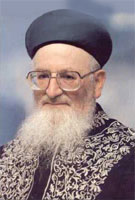Beit Midrash
- Sections
- Chemdat Yamim
- Ein Ayah
Ein Ayah: There are two purposes for building. There is the utilitarian purpose, to create something that protects from cold and rain. The second purpose is to broaden man’s thought process by taking a functional building and making it one that has grandeur and glory. This is described by the pasuk "Like the grandeur of man to live in a house" (Yeshayahu 44:13). The main unique strength of mankind is that his life is founded upon spirituality. Therefore, even those things that are done in order to provide necessities and bring benefits in the simple physical world can go and rise up to the level of grandeur, which uplifts the human spirit. This results in all sorts of elements of improved life. At the end of the process, when all the "impurities are burnt out of material" (i.e., man is adorned), they will be able to bring all of mankind to a lofty level, which is the goal of the foundation of grandeur that lays in the soul of man. For this reason, this second level of building was present in the first creation of the "eternal building" (based on the reference to Chava found in sheva berachot) which man has (i.e., from whom all future generations will come). It was at this point that this reliable foundation was set (i.e., the functional building is not sufficient, but it is worthwhile for it to be adorned). This raises the emotions from the lower level of the natural power, which the animalistic side requires, to the higher level of grandeur, which softens and elevates matters. This is the foundation behind the world of building in all of its meanings, based on his internal value. It is for this reason that the first building was described as "Hashem built the rib," as it represents the grandeur which was present in the process of building by the Creator, the One who made the form. This founded life that keeps the world continuing with the kindness of the G-d of the universe, Who prepared all future generations by decreeing the world into existence. This is the background of Hashem braiding Chava’s hair and presenting her to Adam. It was in this way that the idea of beauty was imprinted upon the nature of the world. It is the emotional element that is added to the necessary part of that which was built. It is for this reason that braiding and sticking down the hair are on practical halachic grounds considered within the halachic category of the Shabbat prohibition of building.

"By G-d- Even Destruction is Constructive"
(Ein Aya Shabbat Shabbat 5, 28)
Rabbi Ari Shvat | Tammuz 5783

The Difference of the Two Temples
Various Rabbis | 5770

influencing Our Families, Cities & the World
Ein Aya Shabbat 5,14
Rabbi Ari Shvat | Shvat 5783



















